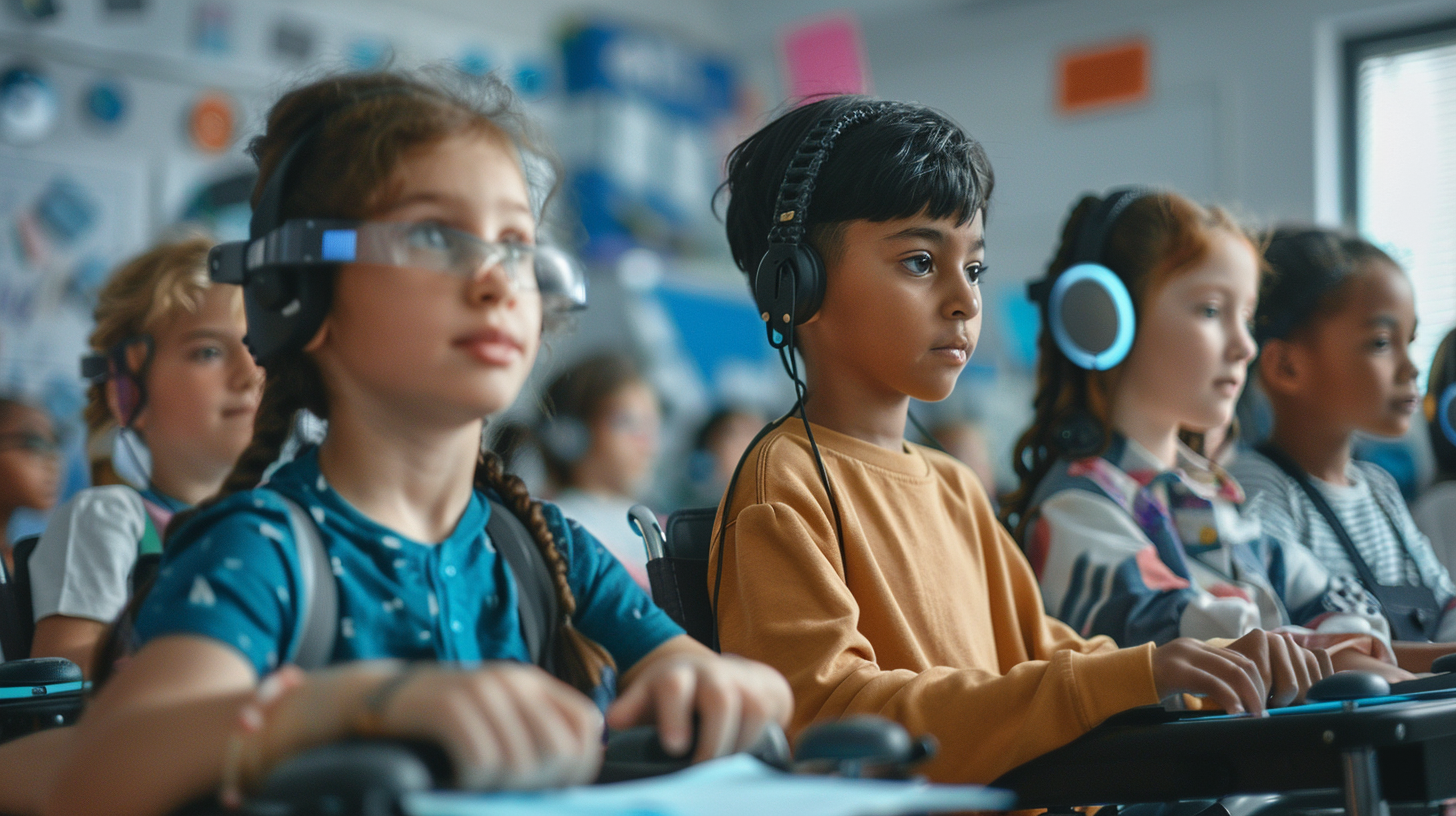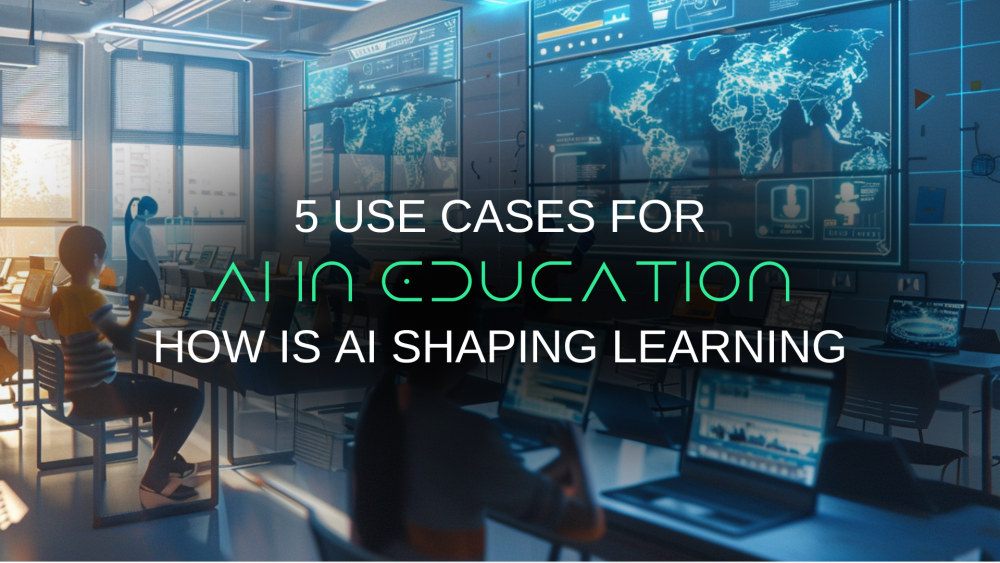AI in Education: 5 Ways AI is Shaping Learning
The potential of AI to transform education is immense. It is already impacting classrooms and learning environments worldwide, and with the growing popularity of e-learning, the impact of AI is set to increase.
According to Statista, the e-learning market is predicted to reach $400 billion by 2026, showcasing AI's potential in shaping our learning. Education institutions and startups are adapting AI to provide students with easier access to knowledge, offering a unique and practical approach to education.
This blog will discuss AI in educational examples and how it transforms learning.
1. Personalized Learning
AI is revolutionizing the way we learn in educational institutions. It can be utilized to create personalized learning experiences for students by adapting to their particular learning needs.
AI-powered educational tools analyze student data to create unique learning paths. These tools use machine learning to adapt how students interact with the lessons. If a student struggles with a particular topic, the AI system might offer additional exercises or explain the concept differently, ensuring students don't fall behind.

AI Tools for Students
Students can now access various AI tools to help them in their educational journeys. These tools enhance learning, offer valuable insights, and provide personalized support. Some popular AI tools for students are listed below:
- Notion: This is an all-in-one workspace for students to organize and manage tasks, notes, and projects. It combines note-taking, task management, and project planning in one platform. Students can use Notion to create to-do lists, take class notes, collaborate with classmates, and stay organized throughout their studies.
- Grammarly: It is an AI-powered writing assistant that helps students enhance their writing skills. It detects and corrects grammar, spelling, punctuation, and style errors in real-time. This tool is handy for students when writing essays, term papers, and other academic assignments.
- Gradescope: It’s an AI-powered grading tool that simplifies the grading process for students and instructors. It enables online assignment submission and automatically grades multiple-choice, fill-in-the-blank, and coding questions. With Gradescope, students receive instant feedback on their work and can track their progress throughout the semester.
- Tutor.ai: This AI-based tutoring platform allows students to schedule virtual tutoring sessions, receive personalized assistance, and get help with challenging subjects or assignments. Tutor.ai offers valuable guidance and support, helping students enhance their understanding of various topics.
2. Task Automation
AI simplifies administrative jobs like grading tests and organizing papers, making learning faster and more effective. Schools can use AI to check homework, grade tests, create reports and presentations, and manage office tasks. This technology makes teachers' jobs easier and ensures tasks are done accurately. It allows teachers to focus on personalized instruction and student engagement, enhancing the learning environment.
3. Enhanced Student Engagement
AI can understand student behavior, preferences, and learning patterns using data analytics. This helps educators personalize teaching methods, support, and interventions to effectively meet each student's unique needs. In addition to written context, AI-driven analytics give students personalized learning and quick feedback, boosting their motivation and engagement.
Tools for Effective Learning
The following tools can be used by teachers to make lessons fun and engaging, encouraging effective learning:
- Canva: Canva is a user-friendly tool that helps teachers design visually appealing worksheets, presentations, and posters. This leads to an interactive and immersive learning experience for students.
- Nearpod: It is a presentation tool for teachers to create interactive lessons with quizzes and activities, engaging students and enhancing comprehension.
- Edpuzzle: This AI-powered video platform enhances videos with interactive quiz sessions and notes, making lessons trackable for teachers. It transforms passive viewing into active learning, allowing educators to personalize lessons and boost comprehension.
- Kahoot: This is a fun learning platform where teachers create interactive quizzes and games for classroom or remote use. It engages students and adapts to any teaching scenario, promoting active learning and retention.
4. Accessibility
AI tools can turn text into speech for visually impaired students and convert speech into text for hearing-impaired students. It can also analyze student data to find learning patterns, predict performance, and suggest personalized learning paths. As AI technology advances, it will offer even more innovative solutions for special education.

Ways AI Can Help Students with Disabilities
AI is used to make learning more accessible for students with disabilities, addressing their apparent and hidden needs. Here are ways in which AI can assist these students:
- Accessibility in Testing: AI-based speech synthesis technology is promising for students using assistive tools, improving rapidly to provide more natural voices. For example, educational testing services used Amazon's tech to replace some human audio with synthesized speech, enhancing user experience by speeding up alternate material production and offering more precise voices for students with disabilities.
- Content Descriptions: AI can help speed up the creation of text descriptions and complex test questions for visually impaired students. It can automatically describe images or provide a first draft for experts to refine or rewrite as needed.
- Webpage Interactions: AI tools like Siri and Alexa can assist people who cannot see by providing spoken interactions with content. Expanding AI features could include a "seeing" AI, helping students navigate visually overwhelming web pages by reading headings aloud. Integrating accessibility into smart devices may reduce the stigma and costs associated with separate tools or apps.
5. AI in Examinations
AI software is crucial for maintaining exam security. These systems use webcams, mics, and browsers to monitor test-takers, detecting unusual behavior through keystroke analysis and behavior observation. They alert managers to protect exam integrity. Educational businesses are increasingly interested in AI to address various challenges in education. It's the perfect time for educators to adapt AI and improve the experience for everyone.
AI Tools in Examination
- Quizbot.ai: This is a powerful AI question generator designed to revolutionize test and quiz creation. Utilizing natural language processing (NLP) algorithms, it interacts with users, allowing them to participate in quizzes and receive instant feedback on their responses. Quizzes can be customized by setting the difficulty level, time limit, and scoring system to suit your needs and preferences.
- Gradescope: It is an innovative online tool that changes how teachers grade students' work. It simplifies the grading process and provides valuable insights into learning. Using AI, Gradescope makes grading faster, more efficient, and consistent. This user-friendly platform allows teachers to spend less time on administrative tasks and more time giving personalized feedback to students.
Examples of Successful AI Integration in Education
Let’s explore some real-life examples of successful AI integration in education.

Georgia State University Using AI in Education
This is a public research university in Atlanta, the largest institution of higher education by enrollment and one of the largest in the nation with student enrollment. It uses an AI-powered advising system to monitor students' academic progress and offer help when needed. This system has boosted graduation rates and reduced the time it takes for students to finish their degrees.
Duolingo Implementing AI in Education
Duolingo is an app and website that offers language learning through fun games, interactive exercises, quizzes, and stories. It utilizes AI to tailor lessons for each user, adapting to their learning speed, errors, and successes. This personalized approach makes language learning efficient and accessible to millions globally.
Nuance Using AI in Education
Nuance Communications is an American software company that sells speech recognition and AI software. Its dragon speech recognition software transforms learning for students and faculty by accurately transcribing up to 160 words per minute. It helps teachers save time in creating lesson plans and aids students in improving spelling and word recognition. This technology benefits those with accessibility needs, enabling them to navigate documents using their voice.
Final Word
The transformative impact of AI in education spans various aspects, revolutionizing traditional learning paradigms and paving the way for a more inclusive and efficient educational landscape. With AI-powered tools facilitating personalized learning experiences, streamlining administrative tasks, enhancing student engagement, and improving accessibility for students with disabilities, the potential for innovation and advancement in education is substantial.
Challenges such as data privacy concerns, equitable access to technology, and the need for ongoing professional development among educators must be addressed to maximize AI's benefits in education. With thoughtful integration and continuous innovation, AI holds the potential to transform education in the future, empowering learners and educators to thrive.





